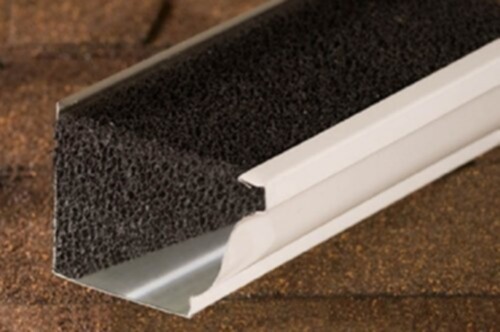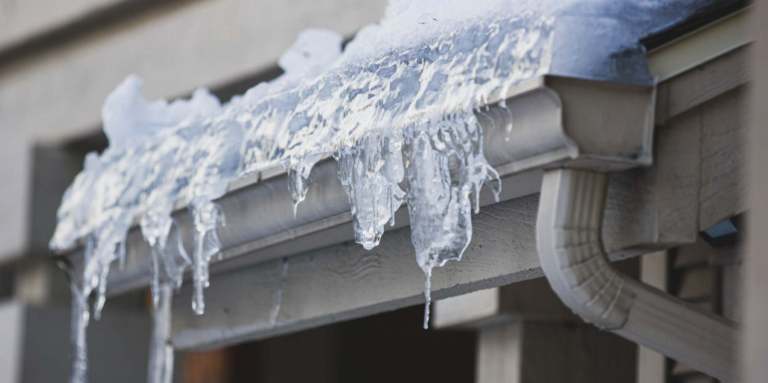Gutter foam guards are long pieces of triangular, arch-shaped foam that fit snugly inside gutters. They are typically made from polyurethane foam or similar and have a spongy, porous texture that allows water to flow through while catching leaves, twigs, and other debris to stop them from causing blockages.
Gutter foam is often regarded as a cost-effective alternative to installing new gutters or guards. In this guide, we take a look at some of the pros and cons of gutter foam and whether it’s the best option for protecting your home.
How does gutter foam work?
There are several different brands of gutter foam on the market. But while they are all slightly different, they tend to work in similar ways.
Slipping them into your gutter manually, gutter foam guards are designed to create a barrier that allows rainwater to flow through while trapping anything that could potentially block your gutter. This filtering action is possible due to the specialized materials used in the foam’s construction, which are often UV-stabilized polyether, polyester, or polyurethane.
Pros of gutter foam
When you’re choosing gutter guards for your home, you’re likely to be faced with a number of options, from one-piece gutter guards to mesh and foam. It can be difficult to know which is right for you, so you need to know the benefits.
Gutter foam offers a number of pros when it comes to protecting your home from the potential for damage, including:
The ability to install it yourself
Gutter foam can be installed without professional assistance, so long as you’re comfortable using a ladder and the appropriate tools. They can also easily be cut to the right shape and size, so they can fit any gutters.
All you’ll need is a pair of scissors or a knife to trim your piece of gutter foam to the right length.
Lower the need for gutter cleaning
While gutter foam guards aren’t a permanent solution to clogged gutters, they can help to prevent any leaves, sticks, and other debris from building up and blocking your gutter.
This can reduce the number of times you need to clean your gutters annually because there shouldn’t be anything causing blockages.
The cost of gutter protection
Gutter foam is fairly inexpensive. Foam materials have low manufacturing costs, which is why gutter sponges are readily available at hardware stores for as little as $2 per foot.
Cons of gutter foam
While gutter foam has some benefits, there are also several potential drawbacks you might want to consider before you choose your gutter solution. It’s important to understand these potential negatives so you can make an informed decision on how to protect your home from the elements.
Not a permanent solution
While gutter foam is inexpensive, it will need to be replaced over time due to the brittle nature of the product. Sitting in direct sunlight for long periods of time and enduring a range of weather conditions, the gutter foam can eventually become dry and fragile. This can ultimately cause the foam to break apart in the gutter, allowing leaves and other debris to cause problems. The broken pieces of foam will also require additional cleanup and could cause more damage to your gutters and building.
Doesn’t work well in heavy rain
Like all sponges and foams, they can only hold so much water. And once they’re full, water will eventually be able to leak out. This is what happens when gutter foam takes in too much water. Gutters are there to take water in a particular direction, but if water builds up and overflows over the edges of the gutter, this can lead to extensive damage to your property.
Smaller debris can get stuck
Gutter foam can still leave room for twigs and leaves to get caught within the small spaces, this can cause more damage in the long run. If seeds get caught in the porous material of the gutter foam, this can also create the perfect habitat for seeds to sprout or mold to grow.
Need to be removed in freezing temperatures
If you live in a place that experiences freezing temperatures, foam gutter guards could be a bad idea. They should be removed when the temperature falls. If they aren’t, they could freeze, and once thawed, you could find yourself with moss, mold, or weeds growing. This means every winter you must remember to find a new solution for the colder months.
Can be a fire risk
Some of the lower-cost foam guards can even present a fire hazard. While this is a worst-case scenario, it’s important to check that anything you’re placing in your gutter is fire retardant and meets certain safety standards.
Can lose shape over time
Foam gutter guards do need cleaning regularly. As mentioned, debris can get lodged there, so rinsing can be very beneficial. However, doing regular cleaning and removing the foam can cause it to lose shape. Once the shape has been lost, it can make it more difficult to be placed back in the gutter correctly, so it may need replacing altogether.
While gutter foam may seem like a cost-effective alternative to traditional gutter guards, it can come with several potential drawbacks. Leafguard however, overcomes many of these problems, making it a better long-term solution. Our gutter systems are designed to handle heavy rainfall and prevent clogs, all while being maintenance-free and lasting for years.
Blog tags


